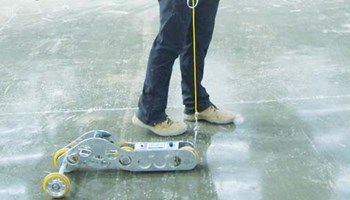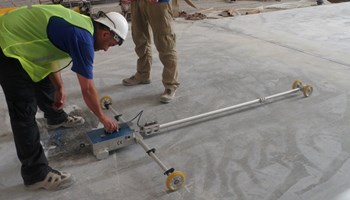Floor Survey & Testing
Flatness Testing
Osis Group is using the latest in digital measuring equipment, to check both Defined and Free Movement floors to TR34, DIN or the American F number specifications.
Why Flatness is important
Correct floor flatness is essential for the following reasons:
- Operations are more efficient if lift trucks operate at Maximum speed.
- Poor surface regularity will cause excessive vibration on a lift truck and increase down time and maintenance.
- Health & Safety and driver fatigue
- Reduced damage to stock.
- Gives control on the general quality of a floor when constructed.
Undoubtedly the most important category of industry where flatness is essential is within aisles of high density warehouses where defined path, very narrow aisles trucks operate.
The static lean table shows how the potential for truck lean is increased by the lifting height.
Property E: To control levelness, the elevational difference in millimetres directly between fixed points 3m apart (not across the diagonals), see Figure 3.4.
Property F: To control flatness, the change in elevational difference between two consecutive measurements of elevational difference each measured over 300mm, see Figure 3.5.
Defined Movement Floors
In Defined Movement (“Superflat”) floor areas the MHE travels in a fixed (defined) path – normally VNA Warehouses with high level storage racking. The higher the Lift Height or racking, the more important the floor flatness becomes
The following properties are defined in Figures 3.8–3.10 as follows:
Property Z: The transverse dimension between the centres of the truck front wheels, in m.
Property X: The longitudinal dimension between the centre of the front and rear truck axles. This is taken to be a fixed 2m.
Property ZSLOPE: The cross-aisle slope between the centres of the truck front wheels in mm/m.
Property dZ: The elevational difference in mm between the centres of the truck front wheels.
Property dX: The elevational difference in mm between the centre of the front axle and the centre of the rear axle.
Property d2Z: The change in dZ in mm over a forward movement of 300mm along the wheel tracks.
Free Movement Floors
In Free Movement floor areas the MHE travels randomly in any direction, for example: Wide Aisle Reach Truck warehouses, Transfer Areas in VNA Warehouses, factories and retail outlets.
Property E: To control levelness, the elevational difference in millimetres directly between fixed points 3m apart (not across the diagonals), see Figure 3.4.
Property F: To control flatness, the change in elevational difference between two consecutive measurements of elevational difference each measured over 300mm, see Figure 3.5.




